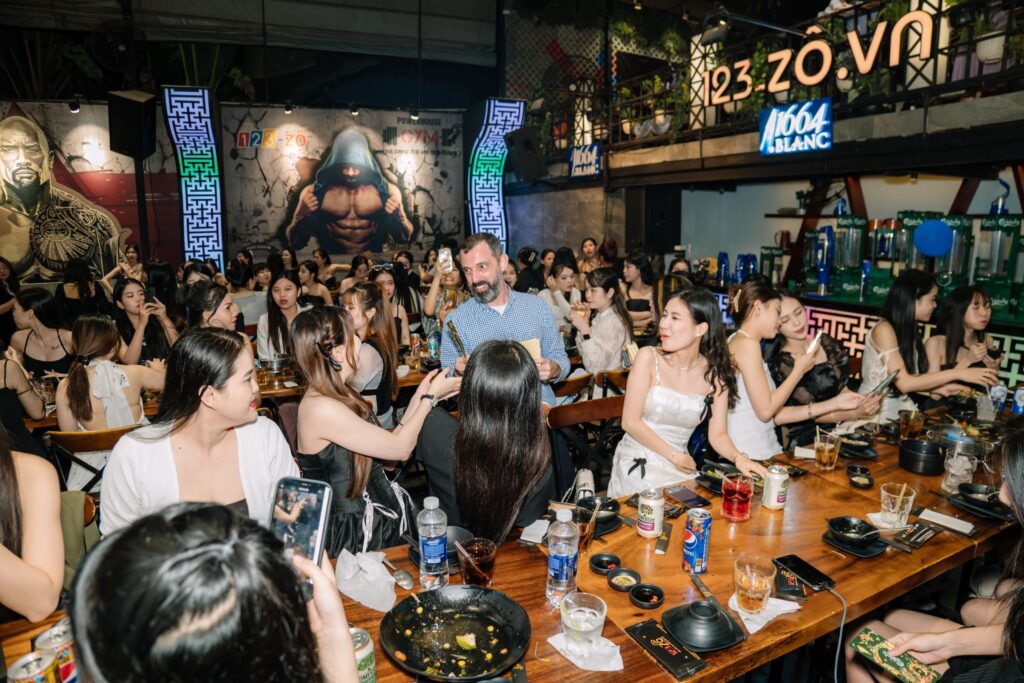Welcome back to VNAround (vnaround.com) – more than a blog, we’re your Viet guide to understanding Vietnam’s traditions and everyday life. Drinking is more than just a social activity in Vietnam; it’s a cultural ritual that fosters connections, strengthens bonds, and celebrates life. Let’s dive into the world of Vietnamese drinking culture and the iconic phrase: “1-2-3 Do!”
1. What is “1-2-3 Do”?
The Meaning Behind the Phrase
“1-2-3 Do” is a Vietnamese toast that translates to “1-2-3 Cheers!” It’s the equivalent of raising your glass and drinking together in harmony. The word “Do” (pronounced “yo”) means “cheers” or “bottoms up.”
How It’s Done
- A leader initiates the chant: “Mot (one), hai (two), ba (three)…”
- Everyone responds loudly with: “Do!” and clinks their glasses.
- You then take a sip—or finish your drink—depending on the occasion.
Why It’s Significant
This ritual embodies the Vietnamese value of togetherness, respect, and camaraderie. It’s a key moment that turns strangers into friends.
2. The Unwritten Rules of Drinking in Vietnam
1. Respect Hierarchy
In Vietnam, age and social status play an important role. When drinking, always pour for elders or those of higher rank first as a sign of respect.
2. Don’t Drink Alone
Drinking is a communal activity. If someone offers a toast, it’s considered impolite not to participate.
3. Clink Glasses Properly
When clinking glasses, ensure your glass is slightly lower than that of an elder or superior as a gesture of respect.
4. Take Turns Toasting
It’s common for everyone at the table to take turns making a toast. Be ready to say a few words when it’s your turn!
3. Popular Drinks in Vietnam
Beer (Bia)
- Vietnam is one of the top beer-consuming countries in Asia. Popular local brands include Bia Saigon, Hanoi Beer, and 333 Beer.
- Beer is often served with ice, a uniquely Vietnamese way of keeping it cold in the tropical heat.
Rice Wine (Ruou)
- Traditional rice wine is a staple at family gatherings and ceremonies.
- It’s typically homemade and can pack a strong punch, so sip cautiously.
Snake Wine (Ruou Mat Ran)
- For the adventurous, snake wine is a specialty infused with snakes or scorpions, believed to have medicinal properties.
Cocktails and Spirits
- In modern cities, you’ll find a growing number of cocktail bars serving international and local creations.
4. Tips for Drinking in Vietnam
Pace Yourself
Vietnamese drinking culture often involves rounds of toasts, so drink responsibly to keep up with the group.
Pair with Food
Drinking is almost always accompanied by food. Dishes like grilled meats, seafood, and pickled vegetables enhance the experience.
Know Your Limits
It’s okay to politely decline another round if you’ve had enough. Simply say “Cam on, toi khong uong duoc nua” (Thank you, I can’t drink anymore).
5. Why You Should Embrace the Tradition
“1-2-3 Do” is more than just a toast; it’s a window into Vietnamese culture. By participating in this ritual, you’ll experience authentic hospitality, make deeper connections, and share unforgettable moments with locals.
At VNAround (vnaround.com), we encourage you to embrace these cultural practices with respect and enthusiasm. Whether you’re clinking glasses over a casual beer or celebrating with traditional rice wine, the spirit of “1-2-3 Do” will leave you with lasting memories.
Resources
- Guide to Beer in Vietnam – Culture Trip – https://theculturetrip.com/vietnam-beer-guide
- Vietnamese Alcohol and Etiquette – Asia Society – https://asiasociety.org/vietnam-alcohol-culture
Let us know your thoughts or experiences with “1-2-3 Do,” and stay tuned to VNAround for more insights into Vietnam’s rich traditions and culture! 🌏



